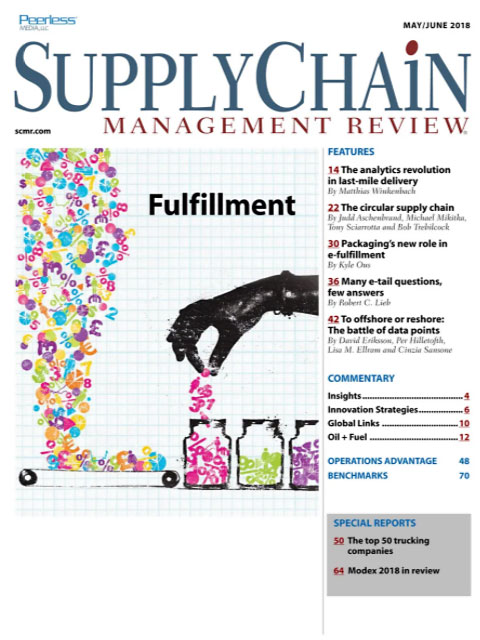Sorry, but your login has failed. Please recheck your login information and resubmit. If your subscription has expired, renew here.
May-June 2018
Last month, I was in Atlanta at the Modex trade show. In one sense, it is a tribute to the automation technologies managing today’s distribution networks. And, I’m not only talking about automated materials handling systems, but also the software and NextGen technologies such as robotics, wearable technologies, including smart glasses and augmented reality solutions and sensors enabling the Internet of Things. In another sense, all of these solutions are coming together to drive fulfillment. With the increase in e-commerce, getting the right product to the right customer at the right time has never been more important. Browse this issue archive.Need Help? Contact customer service 847-559-7581 More options
There is a crisis brewing between shippers and carriers, one being fueled by a perfect storm of carrier capacity constraints, rate increases, driver shortages and government mandates. Growth in the global economy has converged with capacity crunches in Europe, which is experiencing its highest growth rate since 2010, and North America, where the high demand for full truckload shipments is coupled with a shortage of equipment and drivers. Capacity is now at its lowest level relative to demand in the last 10 years.
Government regulation is having an impact. In North America, the ELD mandate took effect in December 2017, with full implementation of ELD required by April 1, 2018. As of this past March, CarrierLists confirmed compliance among long haul carriers in the high 90s, and smaller fleets in the mid 80s. The mandate was expected to have a productivity impact on fleets, but its parallel impact as a reducer of capacity by curtailing Hours Of Service (HOS) cheating has put further pressure on rates. And while the ELD mandate will increase carrier efficiency, as driver time becomes more valuable in 2018, shippers with inefficient systems will see ongoing capacity issues and increased operating costs.
In Europe, a broad new legislation package introduced in May 2017 proposed new regulations on minimum wage rules, weekly rest requirements, cabatoge restrictions, conversion to distance based tolling systems and measures to reduce transport carbon emissions. This new mobility package is predicted to lead to increased logistics costs for carriers, and by extension, for shippers.

This complete article is available to subscribers only.
Log in now for full access or start your PLUS+ subscription for instant access.
SC
MR
Sorry, but your login has failed. Please recheck your login information and resubmit. If your subscription has expired, renew here.
May-June 2018
Last month, I was in Atlanta at the Modex trade show. In one sense, it is a tribute to the automation technologies managing today’s distribution networks. And, I’m not only talking about automated materials… Browse this issue archive. Access your online digital edition. Download a PDF file of the May-June 2018 issue.There is a crisis brewing between shippers and carriers, one being fueled by a perfect storm of carrier capacity constraints, rate increases, driver shortages and government mandates. Growth in the global economy has converged with capacity crunches in Europe, which is experiencing its highest growth rate since 2010, and North America, where the high demand for full truckload shipments is coupled with a shortage of equipment and drivers. Capacity is now at its lowest level relative to demand in the last 10 years.
Government regulation is having an impact. In North America, the ELD mandate took effect in December 2017, with full implementation of ELD required by April 1, 2018. As of this past March, CarrierLists confirmed compliance among long haul carriers in the high 90s, and smaller fleets in the mid 80s. The mandate was expected to have a productivity impact on fleets, but its parallel impact as a reducer of capacity by curtailing Hours Of Service (HOS) cheating has put further pressure on rates. And while the ELD mandate will increase carrier efficiency, as driver time becomes more valuable in 2018, shippers with inefficient systems will see ongoing capacity issues and increased operating costs.
In Europe, a broad new legislation package introduced in May 2017 proposed new regulations on minimum wage rules, weekly rest requirements, cabatoge restrictions, conversion to distance based tolling systems and measures to reduce transport carbon emissions. This new mobility package is predicted to lead to increased logistics costs for carriers, and by extension, for shippers.
SC
MR


Latest Supply Chain News
- AI, virtual reality is bringing experiential learning into the modern age
- Humanoid robots’ place in an intralogistics smart robot strategy
- Tips for CIOs to overcome technology talent acquisition troubles
- There is still work to do to achieve supply chain stability
- Blooming success: The vital role of S&OE in nurturing global supply chains
- More News
Latest Resources

 Explore
Explore
Business Management News
- AI, virtual reality is bringing experiential learning into the modern age
- Tips for CIOs to overcome technology talent acquisition troubles
- There is still work to do to achieve supply chain stability
- Blooming success: The vital role of S&OE in nurturing global supply chains
- Supply chain salaries, job satisfaction on the rise
- How one small part held up shipments of thousands of autos
- More Business Management
Latest Business Management Resources

Subscribe

Supply Chain Management Review delivers the best industry content.

Editors’ Picks






